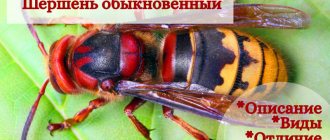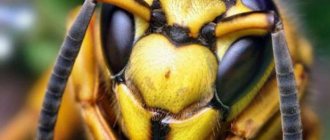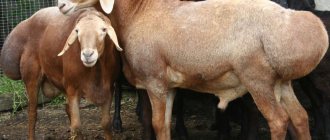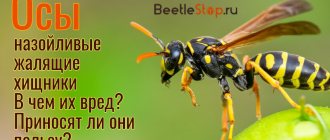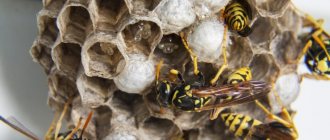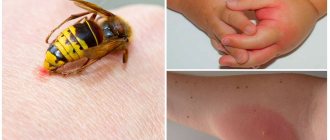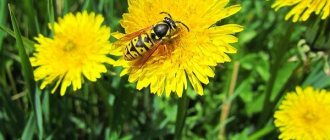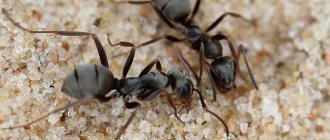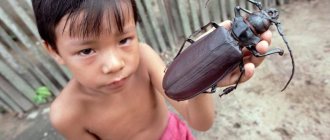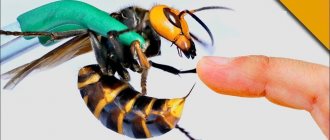Hornets description
Hornets belong to the genus Vespa (wasps). Hornets are the largest and most aggressive representatives of the wasp family, the length of the largest species reaches up to 5.5 cm. There are only about 20 species of hornets in the world. Most live in tropical Asia, but the insects are also found in Europe, Africa and North America, where the European hornet was introduced by humans. The venom of some hornets, such as the Asian giant hornet, is extremely dangerous and the sting can be fatal. The hornet is not aggressive and is unlikely to bite unless you attack it or its nest.
Harm or benefit of hornets
Hornets are often considered pests, especially when they nest near people, because... they will aggressively defend their nest if they feel it is in danger.
Hornets are quite dangerous insects, for example the Asian giant hornet is considered the most dangerous arthropod on the planet. When in danger, the insect releases a special “smell” that attracts other hornets. Hornets can attack humans due to the characteristics of perfume.
Hornets cause particular harm to beekeepers, destroying all the bees in the apiary.
One hornet can destroy up to 10 bees. When one hornet finds a bee colony, it leaves a special scent that attracts other hornets. (There is an opinion that hornets destroy only sick bees, although this fact has not been proven.)) There are cases when bees defeat a lone hornet in a battle, surrounding it.
Hornets whose nests have been destroyed or poisoned are considered especially dangerous. In some countries, it is prohibited to destroy hornets; they are believed to be beneficial for the ecosystem.
Traps and bait
Destroying a nest does not always get rid of all the hornets. The remaining individuals on the site are caught using traps and baits. For this you can use purchased products or those made independently from improvised means and materials.
An excellent bait for them can be spoiled fish, fermented jam or a mixture of honey and beer. In the trade, you can buy the simplest trap to catch insects - sticky tape. A homemade trap can be made from cardboard. It is made in the form of a box, which is covered with a thick layer of honey or fruit syrup.
Have there been hornets on your property?
Was the caseNever
Place traps in places most frequently visited by hornets. Traps are periodically updated, replacing them with new ones. You can also catch insects using glass jars. The bait is placed in them and closed with a lid with a hole made in it in the shape of a cross. The edges of the cut should be folded inside the jar.
Cut off 1/3 of the top from a plastic bottle and insert it, neck down, into the hole in the cap. Place the jar where hornets most often visit. The insects will definitely feel the bait and fall into the trap. Another option for an insect trap is a container with fermented fruit or berry syrup. Install it near the insect habitat.
What hornets look like, their size and structural features
Queen
Hornets have two pairs of wings and six legs. The insect has large and strong jaws. Females are much larger than males. Female hornets have 12 antennal segments. In males 13. Hornet venom contains a large amount of acetylcholine (5%)
Hornet sizes
Hornets vary in size depending on the species.
- Adult European hornets (common hornet) are approximately 2.5-4.5 cm long.
- Eastern Hornet. Dimensions 2.5-3 cm.
- Dybovsky's Hornet - no more than 3.5 cm
- Asian giant hornet - 5.5 cm. Wingspan up to 8 cm.
Appearance
Not everyone knows what a hornet looks like; they confuse it with other types of wasps or with bees. The main features by which a hornet can be distinguished from other insects:
very bright color: yellow or yellow-red head and belly, on which there are black spots and stripes; thoracic segments are black; thin and long transparent wings; large size: the queen has a body length of 2.5-4 cm, weighs about 200 mg. The body of male and worker wasps is slightly smaller; the eyes are red-brown in color and have a unique C-shape; and a small number of hairs on the chest.
There are differences between the body of a female and a male that are hardly noticeable to the naked eye:
the male's antennae have 13 segments, and the female's - 12; the male's abdomen consists of 7 parts, and the female's - 6; the uterus and working females have a modified ovipositor in the form of a sting. Wasps use it to protect the nest and offspring.
How to distinguish a hornet from other insects
Hornets are often confused with other insects, such as wasps and bees.
The difference between hornets and other wasps
Wasp
The nest of hornets is larger in size than that of wasps. Wasp nests can often be found close to or underground, or inside a loose structure, such as between the inside and outside walls of a house or even inside an old sofa.
If the nest is significantly larger and what you believe contains thousands of members, you are most likely seeing a wasp nest.
Unlike wasps that are yellow and black, the hornet has more colors in its color and has orange and brown shades.
Hornets' heads are larger in proportion to their body size compared to other wasps, and the head structure is slightly different.
European hornets have a reddish-brown head, thorax, first abdominal segment and legs.
Be aware of the difference in size between a hornet and a wasp. One of the main differences between a hornet and a wasp, which is easy to recognize both up close and at a distance, is size. The European hornet grows up to 4 cm in length, and the maximum size of the wasp is 2.5 cm.
Note the large width of the head behind the eyes, this region is wider in overall body size in hornets than in other members of the wasp family.
Differences from bees
Bee
The hornet, like the wasp, has a thin waist between the thorax and abdomen, this distinguishes them from the bee family, which has a thick waist between the thorax and abdomen.
Pay attention to the wings (whether the wings are folded along the length of the body), because members of the wasp family fold their wings along the length of their bodies when resting, but bees do not. There are no serrations on the hornet's sting.
A bee sting has serrations; when bitten, the sting is torn out of the bee's abdomen and the bee dies. And hornets, like other members of the wasp family, have a sting without barbs, which allows them to sting repeatedly without losing the sting. The hornet's sting is longer than that of a common wasp or bee sting.
Are wasps human friends?
Exactly. Wasps and hornets are not just “biting creatures”, but our real friends. Not even just friends, but real helpers... I’ll explain point by point why this is so.
1. Wasps (like their close relatives hornets) are active predators that exterminate bloodsuckers.
To feed their numerous offspring, they have to look for insects all summer, which they not only collect wherever possible, but also deftly destroy them on the fly. Like true fighter-interceptors, they can reach high speed, are equipped with an excellent target guidance system and have remarkable intelligence.
Once I watched for an hour on my porch (under which the wasps had built several nests) as they attacked horseflies flying past every few seconds - they grabbed them with their jaws right in the air, dived with their prey onto the grass, and immobilized them if the prey was large.
Often at this moment a second wasp would fly up from the side of the nest to help. A few more movements of the jaws, a short fuss, and all that was left of the horsefly on the ground was its wings. And the heavily laden wasps, loudly ringing their wings, flew into the nest to feed their offspring.
In addition to many horse flies, the same unenviable fate befell several gadflies and a couple of large flies that day.
2. Wasps are the protectors of the garden.
They hunt not only in flight, but also willingly collect many caterpillars, beetles, ants, and other insects (especially those that are too numerous) from trees and from the ground. An outbreak in the number of silkworms - they carry their caterpillars, a lot of moths - they collect moths, aphids have multiplied - this is also good.
In general, wasps in the garden are a “quick response squad”. They perfectly restrain insects that have become too prolific, without being particularly picky when choosing prey.
3. Wasps and hornets are orderlies.
They prevent the spread of infections and parasites. They quickly find dead slugs, frogs, earthworms, lizards, mice, and snails. And they don’t disdain larger carrion, as long as the “meat” is fresh.
Wasps and hornets literally skeletonize the corpse of a mouse or frog in just a few hours, skeletonizing it white.
The first time I observed this was several years ago when we had a cat. The cat (like us) moved into the house from an apartment, so she did not eat the mice caught in the garden, but brought it to us, leaving it on the path near the house.
We usually took the “gifts” to the compost, but several times we didn’t notice. But the wasps noticed them - and by evening, only bones remained from the crushed mouse.
If there are a lot of wasps in the garden, then almost the entire “harvest of meat” goes to them, and not to the corpse flies. And what the wasps didn’t eat during the day, the hedgehogs will eat at night. This, you see, is much more pleasant (I’m talking about smells) and safer (in terms of sanitation).
4. Wasps are pollinators.
Yes, yes, wasps actually pollinate many plants. Personally, I have seen them feasting on nectar more than once. On some plants there are only a few of them, on others there are many. For example, on our flowering ivy there are almost no bees and bumblebees, but there are many, many wasps!
Features of the life of hornets
Hornets are social insects, so they can unite when attacking a victim.
The nests have a strict hierarchical system, with queens dominating hornet hives and being the only females capable of reproducing. Queens lay eggs. Most other hornets are asexual workers who perform important social duties such as building the hive, collecting food, feeding the young, and defending the colony.
There are few males and they have only one role - mating with the queen. Males usually die soon after completing their sexual task.
In colder climates, hornet nests are abandoned in winter; young queens and their eggs survive by finding sheltered areas under tree bark or homes.
In the spring, such a queen will lay a new nest, and soon her young will become workers and take over the duties of the new hive, leaving the queen to breed.
She will produce more workers to expand the hive and before she dies, she will produce a breeding generation of new queens and males (drones) to start everything over again.
What do they eat?
What hornets eat is the following::
- sugary plant juice;
- juice of ripe soft fruits (peach, pear, apple);
- berries (raspberries, blackberries, strawberries);
- sugary secretions from aphids;
- bee products.
These insects are excellent hunters. Their victims include grasshoppers, spiders, and dragonflies. They can also live by feeding on flies, small locusts, caterpillars and close relatives - bees.
Prey is killed with powerful jaws and stings, then moistened with saliva and chewed to form a slurry. But the adult does not swallow this portion of food; she feeds it to the hungry larvae during their dynamic growth.
In 24 hours, a large colony of Hymenoptera feeds its larvae up to 500 g of processed other insects. Some hornets, in addition to catching live prey, also constantly search for dead insects. To live, they do not disdain fish or meat, which people throw away as waste. They actively feed their offspring with all this.
Hornets nests
Hornets nest
Insects create nests by chewing wood into papery building material.
The color of the nest may vary:
- brown
- yellow
- yellow-white
- beige
Often nests can be seen on roof eaves and under decking, tree hollows, birdhouses, caves, and attics. Outdoors, hornets usually build nests high above the ground, such as in trees, on utility poles, or in dense bushes.
Most often the nest is discovered in the fall when the leaves have fallen, by which time most of the hornets will be dead or dying, leaving only the queen to hibernate and survive the winter.
Alarms [ edit | edit code]
Like many social insects, hornets are capable of mobilizing an entire nest and stinging an enemy for the purpose of their own defense. This can pose a danger to both animals and humans. Having detected a threat, the hornet releases an alarm pheromone - a special substance that activates other hornets to attack. It is undesirable to kill a hornet close to the nest, since distress signals can rouse the entire family to attack their offender. The attack can also be triggered by various materials that, due to their chemical properties, easily come into contact with the pheromone, including clothing, skin, dead hornets and their prey, some food seasonings, for example, banana and apple flavors containing C5 alcohols and C10 esters.
Reaction to a hornet sting
If someone is stung multiple times or has a severe allergy to insect venom, systemic reactions may occur that can affect the entire body. Typical symptoms and reactions to bites:
- Strong pain
- Redness
- Swelling around the bite site
If a person is allergic:
- Nausea, vomiting
- Cold extremities
- Blue discoloration of the neck, eyelids, face, ears
- Attacks of suffocation
- Swelling of soft tissues
- Red spots on the body
- Loss of consciousness
